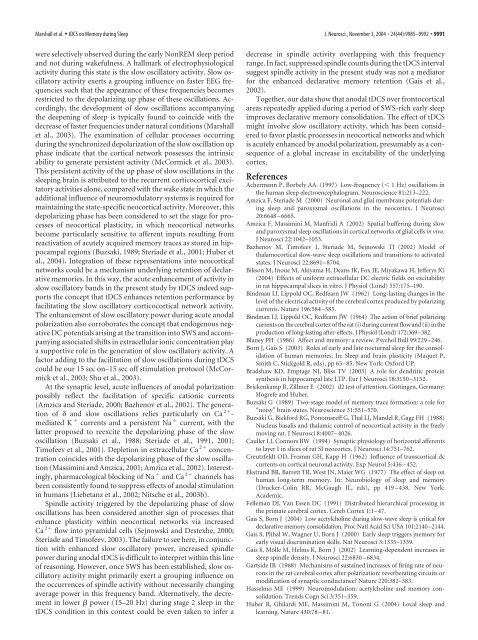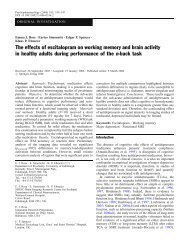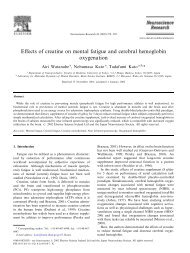Transcranial Direct Current Stimulation during Sleep Improves ...
Transcranial Direct Current Stimulation during Sleep Improves ...
Transcranial Direct Current Stimulation during Sleep Improves ...
Create successful ePaper yourself
Turn your PDF publications into a flip-book with our unique Google optimized e-Paper software.
Marshall et al. • tDCS on Memory <strong>during</strong> <strong>Sleep</strong> J. Neurosci., November 3, 2004 • 24(44):9985–9992 • 9991were selectively observed <strong>during</strong> the early NonREM sleep periodand not <strong>during</strong> wakefulness. A hallmark of electrophysiologicalactivity <strong>during</strong> this state is the slow oscillatory activity. Slow oscillatoryactivity exerts a grouping influence on faster EEG frequenciessuch that the appearance of these frequencies becomesrestricted to the depolarizing up phase of these oscillations. Accordingly,the development of slow oscillations accompanyingthe deepening of sleep is typically found to coincide with thedecrease of faster frequencies under natural conditions (Marshallet al., 2003). The examination of cellular processes occurring<strong>during</strong> the synchronized depolarization of the slow oscillation upphase indicate that the cortical network possesses the intrinsicability to generate persistent activity (McCormick et al., 2003).This persistent activity of the up phase of slow oscillations in thesleeping brain is attributed to the recurrent corticocortical excitatoryactivities alone, compared with the wake state in which theadditional influence of neuromodulatory systems is required formaintaining the state-specific neocortical activity. Moreover, thisdepolarizing phase has been considered to set the stage for processesof neocortical plasticity, in which neocortical networksbecome particularly sensitive to afferent inputs resulting fromreactivation of acutely acquired memory traces as stored in hippocampalregions (Buzsaki, 1989; Steriade et al., 2001; Huber etal., 2004). Integration of these representations into neocorticalnetworks could be a mechanism underlying retention of declarativememories. In this way, the acute enhancement of activity inslow oscillatory bands in the present study by tDCS indeed supportsthe concept that tDCS enhances retention performance byfacilitating the slow oscillatory corticocortical network activity.The enhancement of slow oscillatory power <strong>during</strong> acute anodalpolarization also corroborates the concept that endogenous negativeDC potentials arising at the transition into SWS and accompanyingassociated shifts in extracellular ionic concentration playa supportive role in the generation of slow oscillatory activity. Afactor adding to the facilitation of slow oscillations <strong>during</strong> tDCScould be our 15 sec on–15 sec off stimulation protocol (McCormicket al., 2003; Shu et al., 2003).At the synaptic level, acute influences of anodal polarizationpossibly reflect the facilitation of specific cationic currents(Amzica and Steriade, 2000; Bazhenov et al., 2002). The generationof and slow oscillations relies particularly on Ca 2 -mediated K currents and a persistent Na current, with thelatter proposed to reexcite the depolarizing phase of the slowoscillation (Buzsaki et al., 1988; Steriade et al., 1991, 2001;Timofeev et al., 2001). Depletion in extracellular Ca 2 concentrationcoincides with the depolarizing phase of the slow oscillation(Massimini and Amzica, 2001; Amzica et al., 2002). Interestingly,pharmacological blocking of Na and Ca 2 channels hasbeen consistently found to suppress effects of anodal stimulationin humans (Liebetanz et al., 2002; Nitsche et al., 2003b).Spindle activity triggered by the depolarizing phase of slowoscillations has been considered another sign of processes thatenhance plasticity within neocortical networks via increasedCa 2 flow into pyramidal cells (Sejnowski and Destexhe, 2000;Steriade and Timofeev, 2003). The failure to see here, in conjunctionwith enhanced slow oscillatory power, increased spindlepower <strong>during</strong> anodal tDCS is difficult to interpret within this lineof reasoning. However, once SWS has been established, slow oscillatoryactivity might primarily exert a grouping influence onthe occurrences of spindle activity without necessarily changingaverage power in this frequency band. Alternatively, the decrementin lower power (15–20 Hz) <strong>during</strong> stage 2 sleep in thetDCS condition in this context could be even taken to infer adecrease in spindle activity overlapping with this frequencyrange. In fact, suppressed spindle counts <strong>during</strong> the tDCS intervalsuggest spindle activity in the present study was not a mediatorfor the enhanced declarative memory retention (Gais et al.,2002).Together, our data show that anodal tDCS over frontocorticalareas repeatedly applied <strong>during</strong> a period of SWS-rich early sleepimproves declarative memory consolidation. The effect of tDCSmight involve slow oscillatory activity, which has been consideredto favor plastic processes in neocortical networks and whichis acutely enhanced by anodal polarization, presumably as a consequenceof a global increase in excitability of the underlyingcortex.ReferencesAchermann P, Borbely AA (1997) Low-frequency ( 1 Hz) oscillations inthe human sleep electroencephalogram. Neuroscience 81:213–222.Amzica F, Steriade M (2000) Neuronal and glial membrane potentials <strong>during</strong>sleep and paroxysmal oscillations in the neocortex. J Neurosci20:6648–6665.Amzica F, Massimini M, Manfridi A (2002) Spatial buffering <strong>during</strong> slowand paroxysmal sleep oscillations in cortical networks of glial cells in vivo.J Neurosci 22:1042–1053.Bazhenov M, Timofeev I, Steriade M, Sejnowski TJ (2002) Model ofthalamocortical slow-wave sleep oscillations and transitions to activatedstates. J Neurosci 22:8691–8704.Bikson M, Inoue M, Akiyama H, Deans JK, Fox JE, Miyakawa H, Jefferys JG(2004) Effects of uniform extracellular DC electric fields on excitabilityin rat hippocampal slices in vitro. J Physiol (Lond) 557:175–190.Bindman LJ, Lippold OC, Redfearn JW (1962) Long-lasting changes in thelevel of the electrical activity of the cerebral cortex produced by polarizingcurrents. Nature 196:584–585.Bindman LJ, Lippold OC, Redfearn JW (1964) The action of brief polarizingcurrents on the cerebral cortex of the rat (i) <strong>during</strong> current flow and (ii) in theproduction of long-lasting after-effects. J Physiol (Lond) 172:369–382.Blaney PH (1986) Affect and memory: a review. Psychol Bull 99:229–246.Born J, Gais S (2003) Roles of early and late nocturnal sleep for the consolidationof human memories. In: <strong>Sleep</strong> and brain plasticity (Maquet P,Smith C, Stickgold R, eds), pp 65–85. New York: Oxford UP.Bradshaw KD, Emptage NJ, Bliss TV (2003) A role for dendritic proteinsynthesis in hippocampal late LTP. Eur J Neurosci 18:3150–3152.Brickenkamp R, Zillmer E (2002) d2 test of attention. Göttingen, Germany:Hogrefe and Huber.Buzsáki G (1989) Two-stage model of memory trace formation: a role for“noisy” brain states. Neuroscience 31:551–570.Buzsáki G, Bickford RG, Ponomareff G, Thal LJ, Mandel R, Gage FH (1988)Nucleus basalis and thalamic control of neocortical activity in the freelymoving rat. J Neurosci 8:4007–4026.Cauller LJ, Connors BW (1994) Synaptic physiology of horizontal afferentsto layer I in slices of rat SI neocortex. J Neurosci 14:751–762.Creutzfeldt OD, Fromm GH, Kapp H (1962) Influence of transcortical dccurrents on cortical neuronal activity. Exp Neurol 5:436–452.Ekstrand BR, Barrett TR, West JN, Maier WG (1977) The effect of sleep onhuman long-term memory. In: Neurobiology of sleep and memory(Drucker-Colin RR, McGaugh JL, eds), pp 419–438. New York:Academic.Felleman DJ, Van Essen DC (1991) Distributed hierarchical processing inthe primate cerebral cortex. Cereb Cortex 1:1–47.Gais S, Born J (2004) Low acetylcholine <strong>during</strong> slow-wave sleep is critical fordeclarative memory consolidation. Proc Natl Acad Sci USA 101:2140–2144.Gais S, Plihal W, Wagner U, Born J (2000) Early sleep triggers memory forearly visual discrimination skills. Nat Neurosci 3:1335–1339.Gais S, Mölle M, Helms K, Born J (2002) Learning-dependent increases insleep spindle density. J Neurosci 22:6830–6834.Gartside IB (1968) Mechanisms of sustained increases of firing rate of neuronsin the rat cerebral cortex after polarization: reverberating circuits ormodification of synaptic conductance? Nature 220:382–383.Hasselmo ME (1999) Neuromodulation: acetylcholine and memory consolidation.Trends Cogn Sci 3:351–359.Huber R, Ghilardi MF, Massimini M, Tononi G (2004) Local sleep andlearning. Nature 430:78–81.




